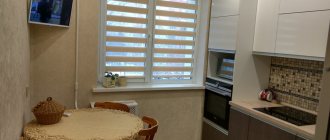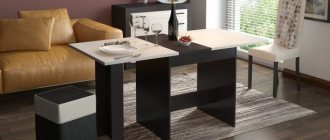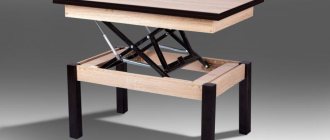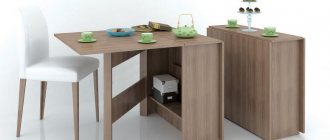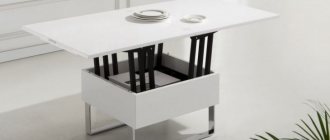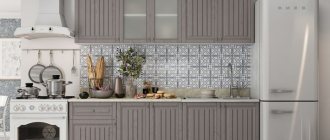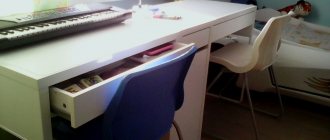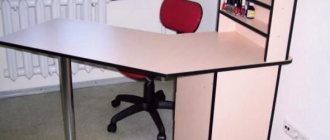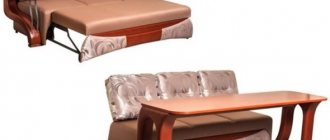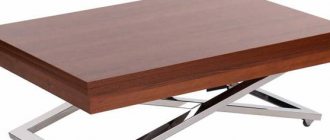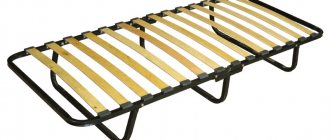The modern pace of life has thrown the calm hearth and home far away. Many people live in small one-room or two-room housing, which is much more profitable and practical. The kitchen is combined with a living room, a bathroom with a toilet, and a bedroom with a work area. In a small area you have to use a minimum number of utensils. But progress does not stand still. Many designers, understanding the needs of customers, have introduced furniture that can be transformed into their collections. This helps not to clutter the space and combine zones in the apartment. In particular, transformable tables have become extremely popular. When folded, the table takes up very little space, and when unfolded it allows you to seat a group of friends.
Transformer tables have become extremely popular.
Transformable table according to GOST
In everyday life, transformable tables are understood as all products that can change their size (tabletop area), shape and height. GOST 20400-80 and TR TS 025/2012 agree with this opinion, which state that “Transformable furniture is furniture, the design of which allows, by moving parts (elements), to change its functional purpose and (or) dimensions.” Functionality means purpose, i.e. dining table, coffee table, dressing table, etc.
However, a narrower division has developed in the professional environment. Transformable tables usually mean tables that can change both the height and dimensions of the tabletop . And products in which only the area of the tabletop changes are classified as folding tables.
In this article we will look at both types of transforming tables.
Transformable table in everyday meaning - changes its functionality
D. Roentgen's table, XVIII century
Transformable table in a highly professional environment - changes the scope of the tabletop and height
Table B2109-3 from Gomlden
Types of transformable tables
The variety of transforming tables is due to the wide range of their purposes. To choose a suitable transformer, first of all , answer the question “which two tables should be combined into one”: a coffee table with a dining table, a kitchen table with a living room table, a wall table with a table table? It all depends on the purpose of the future table, on what role it will play constantly and what role it will play from time to time. Options could be:
- transformable coffee and dining tables,
- transformable dining tables,
- console tables,
- book tables.
Secondly , indicate the requirements for the occupied space: where the table will stand, how much space will be allocated to it, whether it will need to be hidden in a closet or whether it can be a full-fledged piece of furniture. Based on these requirements, select suitable options in the store catalog (see the following illustration):
The resulting sample may include both console tables and folding kitchen tables - it all depends on the given dimensions.
Thirdly , to weed out tables that do not match the complexity of the transformation, set the acceptable parameters:
- who will “unfold” and “fold” it, will there be enough physical strength and dexterity, because transforming tables can weigh up to 70 kg;
- How high are the requirements for aesthetics - will a “simple” option satisfy or is an absolutely flawless appearance both assembled and disassembled extremely important?
Read below about how transformation mechanisms affect the convenience of layout and perfect appearance of tables, but now let’s go over their varieties.
Design options, interior location
When purchasing a folding table, you need to evaluate how well this type of furniture will fit into the existing interior. In this case, you will have to take into account both the installation location and the design of the table, its shape:
- Rectangle or square. It will fit equally well in the living room and in the kitchen.
- Circle or oval. Suitable for spacious rooms.
- Designer form. As a rule, this option is initially intended for the living room, less often - for the bedroom.
You can find transformable tables made from various materials or combinations thereof.
In addition, when installing a table, you should distribute the space so that it does not interfere with movement around the room, the accompanying furniture is of comparable dimensions, and the transformation process itself is carried out as conveniently and effortlessly as possible. It is often placed either against the wall, where it acts as an element of the interior, or between chairs, opposite a window or TV.
A table for a living room is a central accent, so you should select it with special care.
The idea of purchasing such a table may be a good solution if you have limited space or rarely need to use any other furniture. In this case, the “almost all in one” design will be a good option, especially when the living room is also a study, a dining room, and a cinema room.
Coffee and coffee-dining tables
The division of transforming tables into coffee and coffee-dining tables is arbitrary, since they all perform the same task. You can conditionally “attach” tea and coffee tables to them (due to their small size). However, a couple of differences can be found:
- tea and coffee tables are higher than coffee tables;
- In magazine rooms, it is customary to provide storage space for periodicals (magazines and newspapers) under the tabletop.
In general, all of the listed types of transforming tables make up a very wide and very diverse line. Depending on the design features, they are able to change the area of the tabletop, its height, and in some cases, its configuration, i.e. relative arrangement of elements in a volume of space.
The magazine-dining transformer can be a dining
Table B2442-3 from ESF
A magazine transformer remains a magazine
Table Agate 24.10 from DaVita factory
Assembly features after purchase
The transforming table from “Much Furniture”, according to reviews from people who refused the services of the store’s craftsmen, is not easy to assemble. Many people advise not to disdain the carpenters’ offers and not to spare a certain amount for their services. If you still decide to assemble the table yourself, then you need to remember that it is very massive, so it’s difficult to cope with such a job alone. This product includes step-by-step assembly instructions.
The table consists of a base that cannot be transformed. Its upper plane is represented by three elements. Two identical tabletops are twisted on hinges, which are hidden inside when the product is assembled. There is also a steel structure that holds the tabletop raised and a short piece designed to hold the table half. It serves as a support and is the middle link of the transforming table.
Transformable dining tables
It is in this category that, perhaps, it is worth looking for a universal transforming table that is suitable for a living room of any size, including small-sized housing. Particularly interesting for additional requirements are options with “closed” storage spaces. Transformable dining tables are a group that is surprisingly diverse in style and choice of materials. You can find everything in it, from classics to high-tech or modern solutions. That is, depending on the need, choose the basis for a dining group or an option for an independent piece of furniture.
The transformable dining table can reach 2 meters in length
Table Optimata 327 Florida
Advantages and disadvantages
Universal transformable tables for the living room, photos of different variations of which you will find in this material, help to save free space in a limited area and not lose it in practical terms.
When folded, they take up minimal space. At the same time, the full size allows you to accommodate a rather large company.
Transforming tables have the following advantages:
- compactness;
- multifunctionality;
- versatility (coffee, writing, dining tables and cabinets with drawers, shelves, cabinets in one item);
- ease of operation;
- the ability to adjust the size, height and even shape (configuration);
- cost-effectiveness due to the purchase of one item instead of several;
- a variety of models of different designs, designs and prices.
The disadvantages include the cost of some models, for example those made of natural wood. However, there are also quite affordable options on sale that are not inferior in quality.
A question may arise regarding the reliability and durability of the mechanism. This directly depends on the accuracy in use and the original quality of the product. In general, the mechanism is made with the expectation of frequent use.
Console table
The console table is an amazingly versatile piece of furniture. It can be organically fit into absolutely any room, including the hallway, and it will be in place everywhere. Moreover, despite its initially miniature dimensions, when unfolded, the console can take on truly impressive dimensions.
Console table extends from 44 cm to 229 cm in length
Table B2307-1 from Gomlden
Basic qualities
As a rule, the positive aspects of such furniture include:
- Scalability.
- Mobility.
- Multifunctionality.
- Compactness.
- Adaptability.
- Stylish design.
At the same time, the main disadvantages of such solutions include, in fact, the presence of mechanical and moving parts. It is known that the simpler the design, the more reliable it is. Therefore, you need to be prepared that sooner or later, somewhere it will start to jam, and backlash and cracks may appear. In addition, poor-quality fittings and improper care will also affect durability.
Any such table, due to its transformation, can replace several pieces of furniture for you, which, accordingly, saves space.
Additional Information! To be fair, it is worth noting that most of these tables rarely undergo intensive transformation. Therefore, the described shortcomings are more probable than mandatory.
Book tables
A book-table (or cabinet table) is certainly a good option for a small apartment. Not as spectacular as a console, but practical. Especially if it has storage space, like the product in the photo below. Agree, almost each of us has a set - it seems to be necessary, but it takes up so much space, which is always in short supply. Of course, the place for such a table is in the kitchen.
And it is among the book tables that you can find amazingly compact products that, when folded, take up space almost like an ironing board, that is, they can be placed even in a tiny pantry and pulled out only as needed.
Book table with storage drawers
Ultra-thin book table
Product characteristics and features
Having familiarized yourself with all the disadvantages and advantages of the design, you can go in search of a suitable model. You need to focus on your own preferences, the general style of the interior and what specific functional responsibilities will be assigned to the product.
However, it is important to take into account a number of characteristics of transforming tables:
- shape – the most popular are oval designs. They look good in spacious rooms and can be installed in a home with small children. A round transformable table or a square one are more suitable for installation in the kitchen;
- Dimensions – due to the fact that the dimensions of the products can be very different, installation is possible in any room. Of course, most often preference is given to compact designs;
- the transformation mechanism is one of the most important parameters, which in no case should be chosen at random. Some mechanisms fail more often because they were not designed for active use.
Perhaps the most popular is the book table. It has a compact size, so it is suitable for installation in very tight spaces. The main advantage can be considered the fact that the product is equipped with a high-quality and very simple folding mechanism.
Tabletop transformation mechanisms
The convenience and ease of unfolding/folding the table depends on the transformation mechanisms. They can be divided into mechanisms for transforming the tabletop and mechanisms for lifting it. We list the main elements of the tables used in this article:
- tabletop - solid or split horizontal top plate;
- half-tabletop - half of a tabletop;
- insert - a “non-stationary” additional canvas used to increase the area of the tabletop;
- drawer - a vertical “belt” that serves to connect and fasten supports in drawer tables;
- underframe - supports and frame (or crosses, etc.) on which the tabletop is laid;
- corner, roller or ramp for storing inserts;
- supports - legs or side vertical panels.
Tabletop inlays
A solid tab is a removable tabletop element made from a single “sheet”. More often this is a central tab; also one of the options can be considered a folding “wing” of tables-pedestals or tables-books, or a retractable end wing.
One-piece central insert of extendable table
Table Space-6ST from Comfortstol factory
Composite tab - the additional area is formed not by one (as in the case of a solid tab), but by several elements. Special cases of composite tabs are end retractable or the same “double wings” of book-tables.
Note that in some cases, to form a tabletop using solid and composite tabs, you will have to act exclusively with the use of brute physical force. Such elements can be stored either on the ramp under the main tabletop or separately. That is, you will have to manually “remove” the tab or tabs from storage places and install them at places of use, and then repeat all operations in the reverse order. But there are also more modern options that provide a truly comfortable transformation. For more details, see the description of the sliding mechanisms.
Composite end tab of two elements
Ramos table from Avanti
Split butterfly tab - consists of two parts connected by loops. When folded it looks like a “book”. Often (but not always) one of the advantages of such an element is that it is less labor-intensive to fix in place and back. This is possible when a rotary-lever mechanism is used, so you do not have to hold the insert in weight (on your hands). And the most difficult thing in the process is not at all difficult - to open or fold the “wings”.
Central butterfly insert
Table B2303 brand Gomlden
All “sliding” tabs can be located almost anywhere on the tabletop: in the center, at the end or ends. Folding wing inserts - on the side or sides. The insertion location depends on the sliding mechanisms used in the product.
Sliding transformation mechanisms
In drawer tables, transformation of the tabletop, as a rule, is carried out only by moving it; due to the design features, the base (underframe) remains in place.
In tabletops without frames, supports are involved in the transformation - as the area of the tabletop increases, they move relative to each other. There are intermediate transformation options such as “frontslide”. To maintain the strength, reliability and stability of the unfolded product, additional supports under the tabletop can be used.
Tsar tables
Non-synchronous sliding mechanisms with drawer fastening . This option is rare nowadays and is typical for classic sliding tables with a central insert. The transformation is carried out by extending the half-table tops alternately - from one side and then from the other.
Synchronous sliding mechanisms for transforming drawer fastenings are more convenient - you only need to pull one part of the tabletop, the second will extend in the opposite direction on its own due to the cable connection.
A synchronous mechanism can be identified by the presence of cables in the mechanism
Bacchus table, Belarus
Tsar fastening mechanisms can be internal or external. The internal ones are completely invisible from the outside; they can be used with material of any thickness. But they have strict restrictions on the length of the insert. External fastening mechanisms are less aesthetically pleasing, so they are more often used in models with decorative false drawers. But this mechanism allows you to install a slightly larger insert than for drawer tables. As a rule, drawer tables use one solid central insert with a width of 340 to 650 mm.
The false drawer closes the sliding mechanism
Transforming table Versailles, made in Russia
Frontslide
The frontslide sliding mechanism differs from the traditional drawer and drawerless in that only two supports with a side drawer move, and the tab is located not in the middle, but at the end of the table. This solution allows you to increase the length of the tabletop to 640 mm.
Frontslide mechanism - not only the tabletop moves, but also the supports
Lars table from ItalGruppo
Tsarless tables
Multi-joint sliding mechanisms with drawer-less fastening make it possible to change the size of the tabletop step by step, placing the required number of inserts. The transformation is performed on one side, extending the support (legs) in the horizontal direction. A typical example of application is a console table. The disadvantage of this mechanism is that there is not always space to store inserts and the need to use additional support. Plus - the possibility of a very significant increase in the length of the tabletop - several times relative to the starting size.
Multi-joint sliding mechanism with drawer-less fastening
Giant console table from Levmar, Russia
Slightly less complex synchronous sliding mechanisms without drawers are used not in consoles, but in large dining tables. They are just as convenient as synchronous drawer panels, but thanks to them you can use not one, but several inserts, seriously increasing the area of the tabletop. With such mechanisms you can increase the length of the table up to 2000 mm. In this case, the composite inserts can be stored under the tabletop.
Synchronous sliding mechanism without drawer fastening
Transformable table Optimata 303S
Sliding non-synchronous mechanism for the end lifting of the table top with gas lift. The transformation is performed by pulling and pushing up the tabs from the ends of the table. Does not require any serious physical effort, ideal for people of fragile build. One of the advantages is the ability to increase the area on both two and one sides by 300 and 600 mm, respectively.
Pull the additional tab out from under the tabletop and lift it up - it will take its place
Wide extendable table Colombo from ItalGruppo
Sliding synchronous mechanism with automatic lifting of the insert . The transformation is performed by pulling out the half-tabletop from one side until it stops. The second half changes position synchronously, and the central insert independently rises level with the main ones. Everything is very simple and even ladies of delicate constitution can do it. The size of the central insert is about 300-320 mm.
Automatic insert lifting and synchronous sliding
Anton table from ItalGruppo
Butterfly
A table with such a mechanism is a coffee table with shelves for storing small items. But if necessary, the shelves can be pulled out. An automatic mechanism consists of two planes located opposite each other. When one expands, the second unfolds automatically. The mechanism is durable and practical.
Perfect if you don’t like to clutter up the space with massive high tables for dining, but at the same time value sophistication and comfort.
Folding transformation mechanisms
The classic folding mechanism is implemented in book tables. In the folded position, the “wings” of the tabletop hang on the sides of the table. To unfold the table, they are lifted and a support leg is installed under them.
The sliding-folding mechanism is used with book-like tabletops (“double” split tabletop with a hinged connection). When folded, it lies on the frame. The transformation is performed by first moving the folded tabletop to the side, and then “opening” it like a book.
Sliding-folding mechanism for transforming the tabletop
Table VM50 from Logart factory
The rotating and folding mechanism is also used for “folded” tabletops. Unlike the previous option, here the folded tabletop must first be rotated around a horizontal axis on the support platform and then unfolded.
Rotating and folding mechanism for transforming the tabletop
Table Agat 19.2, Russia
Folding mechanisms, of course, require a little less effort than sliding ones with manually installed inserts. But more than sliding ones with automatic fixation of inserts. If the tabletop is large enough, the weight will be felt when unfolding and folding. There is also a risk of pinching your fingers, which is familiar to all owners of a classic Soviet folding table from childhood.
The disadvantages of folding tables are that the aesthetics are not high enough both when folded and unfolded. The loops are visible. In addition, when unfolded, the tabletops are not strong enough and if there is an excessive load on the edges, they “go to break” - it will be impossible to sit and lean on the edge of the unfolded tabletop.
Tabletop lifting mechanisms
Tabletop lifting mechanisms can be divided into mechanical, pneumatic and electric.
Electric ones are rarely used and are not particularly in demand at home. We do not consider them in this article. Mechanical and pneumatic are similar in durability and reliability, the only difference is in convenience and ease of use.
Lever lifting mechanisms can be purely mechanical with hinges, springs, or they can incorporate pneumatic cylinders (then they are pneumatic). They do not require any serious effort, the transformation is quite comfortable and safe.
Raising the tabletop by folding out the supports is implemented in the Alexandria or Agat-24.10 tables (below in the photo). We do not recommend using a system like Alexandria for women and children - a certain amount of physical strength is required.
Lifting by folding out supports. Disadvantages: backlash, loosening
Transformable table Alexandria
Lifting by lifting the steel support mechanism
Transforming table Agat 24.10
The scissor-type lifting mechanism is implemented in all products with crossed legs (X-shaped supports). Lifting can be done mechanically or pneumatically.
The mechanical system, of course, requires more physical strength than the pneumatic one, especially when fixing the height with a screw (it is necessary to hold the table suspended, tighten the screw and fix the height of the table top).
To prevent damage to floor coverings when lifting and folding tables with scissor legs, in the vast majority of cases, some kind of protective devices are provided on the legs. These can be hidden rollers, wheels, external rollers, etc. One of the significant advantages of such transforming tables is their very low folded height (for some models it is only about 30 cm). This makes it possible to completely remove a product with insufficiently high aesthetics out of sight after use - hide the table in a pantry or closet.
Scissor lift (X-shape support) plus gas lift. Height can be from 30 cm
Table B2293 brand Gomlden
The lift-type lifting mechanism with gas lift (pneumatic cylinder) is not only convenient, but also effective. For example, the table with a column base, which you see in the photo below, looks simply amazing. Engineers and designers often offer telescopic single- and double-support options, and the supports can be rectangular, round, oval, or even made in the form of classic legs. Gas lifts, depending on the design, can provide stepwise or stepless fixation of the tabletop in height. This solution does not require serious physical effort.
Lifting mechanism with gas lift: convenient and easy
Transformable table Optimata 312
Lift
The biggest difficulty in assembling a transforming table from “Much Furniture” (according to consumer reviews) is tensioning the springs in the lifting mechanism of the product. They are attached at one end to a hole located on the inner surface of the lift. Next you will need to insert a pin into the groove. It is put on the other end of the spring.
When the springs have taken their place indicated in the diagram, you need to screw the lifts first to the long and then to the short frames of the table top.
The men found this work difficult, but they completed it. According to reviews from women who tried to assemble the table themselves, they were unable to tension the spring. This process requires male participation.
Materials for transformable tables
To make transforming tables, they use absolutely everything that the industry offers. The choice is determined only by taste and stylistic preferences and environmental requirements. Please note that all materials are approved for use in everyday life, in residential and commercial premises. But if environmental friendliness ranks high on the list of selection criteria, let's say the following.
Metal and glass. They can be given leadership in environmental friendliness. There is simply nothing to complain about here. The materials are durable and can be refreshed by polishing. Well, you can’t drop heavy and sharp objects onto any tabletop.
Wood and veneer. Contrary to popular belief, even in the 16-19 centuries. it was solid wood of valuable or more or less valuable species that was used extremely rarely. In the vast majority of cases, it was a question of a base made of cheap wood, veneered (veneered) with more expensive species. Yes, MDF or chipboard was not used, but, rather, because such technology simply did not exist. Nowadays, wood-based panels are orders of magnitude safer than those produced half a century ago, so there is no need to be afraid of them. Veneered tables are just as, and in some cases more, beautiful than solid wood products.
Plastic. Synthetic materials are used both as small fittings and to create the most durable and textured coating on MDF or chipboard. We repeat: subject to operating conditions, they are safe.
detailed instructions
By reading reviews of furniture about a transforming table from “Lots of Furniture,” you can find out how home craftsmen coped with the assembly diagrams. The table is sold completely disassembled and packed in a cardboard box. All fittings and fastenings are provided by the company in separate bags.
First, assemble the corner legs. Confirmations are used for this. Then four frame frame strips are made from available spare parts. Next, the parts of the body and legs are connected.
Positive customer reviews about the transforming table from “Much Furniture” note that it does not scratch the flooring. Special thrust bearings are nailed onto its legs with a hammer, which soften the pressure of the furniture on the floor. You will also have to nail shock absorbers onto the upper end parts of the frames during assembly. This is necessary so that the table does not knock on the base when folding.
